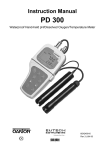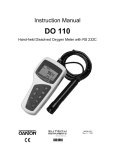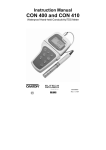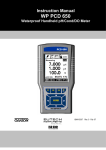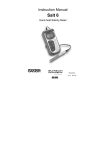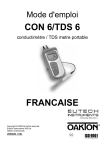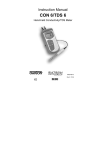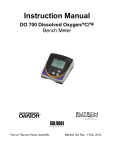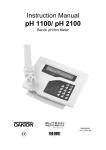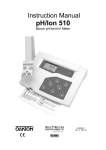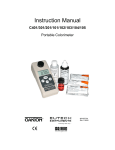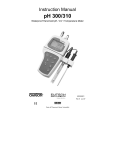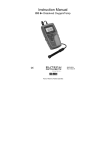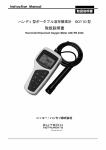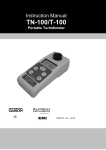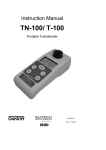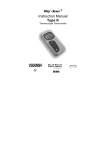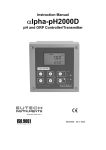Download EUTECH INSTRUMENTS CYBERSCAN DO 1500 DO METER Instruction manual
Transcript
Instruction Manual DO 300 Waterproof Hand-held Dissolved Oxygen / Temperature Meter 68X248909 Technology Made Easy ... Rev 3 02/04 Preface This manual serves to explain the use of the Waterproof DO 300 hand-held meter. It functions in two ways, firstly as a step by step guide to help you to operate the meter. Secondly, it serves as a handy reference guide. It is written to cover as many anticipated applications of the Waterproof DO 300 meter as possible. If there are doubts in the use of the meter, please do not hesitate to contact the nearest Authorised Distributor. Eutech Instruments/ Oakton Instruments cannot accept any responsibility for damage or malfunction to the meter caused by improper use of the instrument. The information presented in this manual is subjected to change without notice as improvements are made, and does not represent a commitment on the part of Eutech Instruments Pte Ltd/ Oakton Instruments. Copyright © 2000. Eutech Instruments Pte Ltd/ Oakton Instruments All rights reserved. Rev 3 02/04 TABLE OF CONTENTS 1 INTRODUCTION 2 DISPLAY AND KEYPAD FUNCTIONS 2.1 2.2 3 3.1 3.2 4 4.1 4.2 4.3 4.4 5 5.1 5.2 Display Keypad Inserting the Batteries Connecting the Probe CALIBRATION Preparing the meter for calibration Temperature Calibration Dissolved Oxygen Calibration in % Saturation Dissolved Oxygen Calibration in mg/L (ppm) mode MEASUREMENT Taking DO readings Taking Pressure/Salinity Compensated DO measurements HOLD FUNCTION 7 MEMORY FUNCTIONS 8 8.1 8.2 8.3 8.4 8.5 8.6 8.7 8.8 8.9 8.10 9 9.1 9.2 9.3 9.4 9.5 2 2 3 PREPARATION 6 7.1 7.2 1 Memory Input Memory Recall ADVANCED SETUP FUNCTIONS Advanced SETUP Mode Detailed Overview Clr: Memory Clear dPr: Dissolved Oxygen Parameters OFS: Offset for % Saturation Measurement CAL: Previous Calibration Information ELE: Electrode Properties COF: Unit Configuration LCd: Adjusting LCD Brightness CLO: Setting the Real-Time Clock rSt: Resetting to Factory Default Setting PROBE CARE AND MAINTENANCE Probe Care Membrane Housing Replacement Membrane/O-ring Replacement (Optional Procedure) Electrolyte Solution DO Probe Troubleshooting Table 4 4 5 6 6 7 8 10 11 11 13 14 15 15 16 17 18 20 21 24 25 26 28 32 33 35 36 37 38 39 41 42 10 TROUBLE SHOOTING GUIDE 44 11 ERROR MESSAGES 45 12 SPECIFICATIONS 46 13 ACCESSORIES 47 14 DISSOLVED OXYGEN & METER THEORY 49 15 PRESSURE VS ALTITUDE TABLE 50 16 FACTORY DEFAULT SETTINGS 51 17 OVER-VIEW OF SETUP FUNCTIONS 52 18 WARRANTY 56 19 RETURN OF ITEMS 56 Instruction Manual 1 DO 300 INTRODUCTION Thank you for selecting the DO 300 waterproof portable meter. This meter is a microprocessor-based instrument that is designed to be handy and capable of allowing onehand operation. It is capable of measuring Dissolved Oxygen in mg/L or ppm, % Saturation of Oxygen and Temperature. It is completely WATERPROOF --- and it FLOATS! This meter has many user-friendly features ---- all of which are completely accessible through the water-resistant membrane keypad. Your meter includes a dissolved oxygen / temperature probe with submersible cable (inclusive maintenance kit), instruction manual, and a warranty card. Please read this manual thoroughly before operating your meter. Figure 1: Waterproof DO 300 Dissolved Oxygen Meter 1 Instruction Manual 2 DO 300 DISPLAY AND KEYPAD FUNCTIONS 2.1 Display The LCD has a primary and secondary display. o The primary display shows the measured DO value either in mg/L, ppm or %, depending on units of measurement selected. o The secondary display shows the measured temperature in °C. The display also shows error messages, keypad functions and program functions. See Figure 2. Figure 2: Full LCD Screen 1. SETUP mode indicator 8. Temperature indicator 14. Probe indicator 2. MEASurement mode indicator 9. Automatic Temperature Compensation indicator 15. Calibration indicator 3. CALibration indicator 10. Clock indicator 16. DO probe cell factor 4. MEMory recall mode indicator 11. ERRor indicator 17. Function ON / OFF indicator 5. % saturation indicator 12. MEMory location indicator 18. HOLD indicator 6. ppt indicator for input of Salinity value. 13. Low battery indicator 19. READY indicator 7. Oxygen solubility indicator in mg/L or ppm. 2 Instruction Manual 2.2 DO 300 Keypad The large membrane keypad makes the instrument easy to use. Each button, when pressed, has a corresponding graphic indicator on the LCD. See Figure 1. Some buttons have several functions depending on its mode of operation. Key Function ON/OFF Powers meter on and off. The meter powers on in the mode that you were last using. For example, if you shut the meter off in mg/L measurement mode, the meter will be in mg/L measurement mode when switched on. Note: The meter shuts off automatically after 20 minutes of the last key press. HOLD Freezes the measured reading. To activate, press HOLD while in measurement mode. To release, press HOLD again. NOTE: When auto endpoint feature is switched on, it automatically holds reading after 5 seconds of stability. The HOLD indicator appears on the display. Press HOLD to release auto endpoint feature. MODE 1. Selects the measurement parameter. Press MODE to toggle between DO % saturation; DO mg/L (or ppm) and date/time. 2. While in CAL mode under mg/L (or ppm) measurement status, this key will toggle between mg/L (or ppm) calibration and temperature calibration (refer to section 4.2) CAL/MEAS Toggles between Calibration and Measurement mode. 1. In DO % saturation measurement mode, press CAL/MEAS to enter DO % saturation calibration mode. 2. In DO mg/L (or ppm) measurement mode, press CAL/MEAS to enter DO mg/L (or ppm) calibration mode. 3. To abort calibration, press CAL/MEAS key again to go back to measurement mode. While in advanced SETUP mode: Press CAL/MEAS to return to main group menu from sub group menus. Press CAL/MEAS again to return to measurement mode from main menu. ENTER 1. Press to confirm your calibration values in calibration mode. 2. While in SETUP mode, pressing the ENTER key confirms the main group menu selection and takes you through each sub group menu. MI/ MR/ SETUP & In Measurement mode: Press MI key to store the mg/L (ppm) or % Saturation values with its corresponding temperature and date/time values, into the memory. Press MR to retrieve data from memory in LIFO method. In Calibration & Set up mode: In DO mg/L (or ppm) and temperature calibration mode, press or keys to increase or decrease the calibration values. In SETUP mode, press or keys to scroll through the SETUP main group menu and to set the parameters in the sub group menu. Takes you into the SETUP mode. This mode lets you customise meter preference and defaults, view calibration and electrode data. LIGHT : Press to light up the backlit display. 3 Instruction Manual 3 3.1 DO 300 PREPARATION Inserting the Batteries Four AAA batteries are included with your meter. 1. Use a Philips screwdriver to remove the two screws holding the battery cover. See Figure 3 below. 2. Remove battery cover to expose batteries. 3. Insert batteries. Follow the diagram inside the cover for correct polarity. 4. Replace the battery cover into its original position and secure into place using the two screws removed earlier. Figure 3: Back panel of meter showing meter compartment 4 Instruction Manual 3.2 DO 300 Connecting the Probe Your meter uses a dissolved oxygen/temperature probe. The probe cable has a notched 6-pin connector to attach the probe to the meter. NOTE: Do not substitute other probes. For a replacement probe, see the “Accessories” section, page 47- 48. NOTE: Keep connector dry and clean. Do not touch connector with soiled hands. To connect the probe: 1. Line up the notch and 6 pins on the meter’s connector with the holes in the probe’s connector. Push down and turn the locking ring to lock into place. See Figure 4 below. 2. To remove probe, unscrew the metal locking ring by turning the ring counterclockwise and slide up the probe connector. While holding onto metal sleeve, pull probe away from the meter. CAUTION: Do not pull on the probe cord or the probe wires might disconnect. Figure 4: Connect DO Probe 5 Instruction Manual 4 4.1 DO 300 CALIBRATION Preparing the meter for calibration The amount of oxygen dissolved in water will depend on its temperature, atmospheric pressure and its salinity. While the pressure and salinity values are manually entered into the instrument, the temperature is being measured by the probe. It is therefore very important that the temperature is calibrated if necessary prior to the DO calibration. The measurements of % Saturation of DO will linearly affect the measurement for DO in mg/L. Hence calibration in % Saturation of DO should be carried out first. Before calibrating your meter, make sure to rinse the probe well with DI (de-ionised) water or rinse solution. NOTE: Do not let membrane surface of the probe touch any other surface. The probe guard (the piece with holes fitted over the end of the probe) protects the membrane; make sure this is always attached to the probe while it is in use. You can calibrate for dissolved oxygen in either % saturation or mg/L (ppm). When you recalibrate your meter in % saturation mode, old calibrations in % saturation will be replaced while the % saturation offset adjustment will be erased. However, recalibration in the Figure 5: DO Probe guard mg/L (ppm) concentration mode will only replace the old calibration in the mg/L (ppm) mode and do not affect the calibration in the % saturation mode. Before Calibration Before starting calibration, make sure you are in the correct measurement mode. When you switch on the meter, the meter starts up in the mode last used (either in mg/L (ppm) or % Saturation measurement mode or clock). For example, if you switch the meter off while it is in the “mg/L” measurement mode, it will also be in the “mg/L” measurement mode when you switch the meter on. 6 Instruction Manual 4.2 DO 300 Temperature Calibration DO in mg/L is dependent on temperature, so it is first necessary to verify the temperature reading. Temperature calibration is accessible from the mg/L or ppm measurement mode. The built-in temperature sensor in the probe is factory calibrated. Calibrate your sensor only if you suspect temperature errors may have occurred over a long period of time or if you have a replacement probe. 1. Dip the DO probe into a solution with known temperature. Allow sufficient time for the temperature to stabilise. NOTE: Use an accurate temperature meter or bath to determine the solution’s temperature. 2. Ensure that the meter is in measurement mode. Press MODE key if necessary to select mg/L mode. 3. Press CAL key to go into calibration mode of mg/L. The primary display shows the measured DO in mg/L and the secondary display shows the temperature. 4. Press MODE key to go into temperature offset adjustment mode. The primary and secondary displays will show the temperature values. 5. Press MI/ or MR/ key to set the correct temperature value. NOTE: Temperature calibration is restricted to ± 5°C from the factory default value displayed during calibration (shown in the secondary display). 6. Press ENTER key to confirm the adjusted temperature. NOTE: To exit from Temperature Calibration mode without confirming calibration, DO NOT press ENTER in Step 6. Press CAL/MEAS instead. Since temperature readings affect the accuracy of the mg/L measurements, it is strongly recommended to carry out a mg/L calibration after a temperature calibration is done. (The values shown above are for illustration purpose. Your meter may display different values depending on the settings & your environmental conditions) 7 Instruction Manual 4.3 DO 300 Dissolved Oxygen Calibration in % Saturation You can calibrate this meter quickly and easily in air. The exact calibration value depends on barometric pressure. The meter is set to a factory default of 760 mm Hg, which results in a calibration value of 100% saturation in air. NOTE: If the barometric pressure setting has been changed from 760 mm Hg, the calibration value in air will automatically adjust to a value other than 100%. The adjusted value will be correct for the new barometric pressure setting. See page 21 to change the pressure setting. See Pressure vs Altitude Table on page 50 for a table of adjusted % saturation values. To calibrate 100% Saturation: 1. Press MODE key to select % Saturation mode. 2. Rinse the probe well with deionised rinse water. For best accuracy, wipe the end of the probe dry. Do not touch the membrane. 3. Hold the probe in the air with the sensor facing down and press CAL key to calibrate the meter. The LCD will show a “CAL” mode. The primary display will show the current value of measurement and the secondary display will show “100.0” to which the meter is going to be calibrated. Wait for the reading to stabilise. 4. Press ENTER key to confirm the calibration. The meter automatically calibrates to 100% air saturation and returns to the measurement mode. NOTES: Whenever an error occurs during calibration, the ERR indicator appears in the lower left hand corner of the display. You can offset your % DO calibration. See section 8.4 - OFS: Offset for % Saturation Measurement on page 24 for directions. 8 Figure 6: To calibrate for 100% saturation Instruction Manual DO 300 To calibrate 0% Saturation: 1. Rinse the probe well with DI rinse water. For best MEAS accuracy, wipe the end of the probe dry. Do not touch the membrane. 2. 3. % 8.5 READY 23.4 Press the MODE key to select the % saturation mode. °C ATC Place the probe in zero oxygen solution. Stir the solution L CA AS ME gently using the probe to homogenize the sample. Make sure that the sample is continuously flowing past the membrane sensor. CAL % 4. Press the CAL key. The CAL indicator will appear above the primary display. The primary display will show the factory default % saturation measurement and the secondary display will show 0.0. 5. ER ENT Wait for the reading to stabilise. If the READY indicator feature is enabled, it will appear when the reading is stable. (See section 8.7.1 on page 29 for Ready indicator MEAS % READY setup). 6. Press the ENTER key. The meter automatically calibrates to 0.0% saturation and returns to Measurement mode. 23.4 °C ATC Figure 7: To calibrate for 0.0% saturation See figure on right. NOTE The factory default % saturation measurement in step 4 must read at 10% or under for the calibration to work correctly. Whenever an error occurs during calibration, the ERR indicator appears in the lower left hand corner of the display. 9 Instruction Manual 4.4 DO 300 Dissolved Oxygen Calibration in mg/L (ppm) mode Calibrating the meter to 100% in saturation mode will also calibrate the mg/L mode at the value in mg/L corresponding to 100% saturation. This should produce acceptable results in most applications. This meter also lets you make a calibration adjustment in mg/L (ppm) mode without affecting your % saturation calibration. To select between mg/L and ppm units, see page 30. To calibrate in mg/L (ppm) mode: 1. Calibrate 100% saturation as per Section 4.3. 2. Rinse the probe well with DI rinse water or rinse solution. For best accuracy, wipe the end of the probe dry. Do not touch the membrane. 3. Press the MODE key to select the mg/L (ppm) mode. 4. Dip the probe into a sample of known oxygen concentration. Wait for the reading to stabilise. If the READY indicator feature is enabled, it will appear when the reading is stable. 5. Press the CAL key. The CAL indicator will appear above the primary display. The primary display will show the factory default mg/L (ppm) measurement and the secondary display shows the temperature. 6. Press the MI/ or MR/ keys to set the reading according to the sample value. 7. Press the ENTER key. The meter automatically calibrates to the value you entered and returns to Measurement mode. Notes on mg/L (ppm) mode calibration • During mg/L (ppm) measurement and calibration, the meter adjusts to the barometric pressure value and the salinity value that is programmed into the meter • You can change the barometric pressure value and salinity value in the mg/L (ppm) SETUP mode (see section 8.3 on page 21 for directions). • Whenever an error occurs during calibration, the ERR indicator appears in the lower left hand corner of the display. 10 Figure 8: To calibrate in mg/L (ppm) mode (The values shown above are for illustration purpose. Your meter may display different values depending on the settings & your environmental conditions) Instruction Manual 5 DO 300 MEASUREMENT 5.1 Taking DO readings During measurement, the probe can be: z Fully immersed in the solution z Partially immersed in the solution Do not allow the probe’s membrane surface to touch anything! It is always advisable to insert the probe guard (refer to Figure 34 and 35 on pages 38 and 39) IMPORTANT: Since the DO probe consumes oxygen from the sample, the sample must constantly flow past the membrane to achieve more accurate readings. You can use a stirrer to accomplish this. To take measurements: 1. 2. Rinse the probe well with DI rinse water or rinse solution. Select the appropriate measurement mode. Press the MODE key to toggle between modes: 3. z % Saturation z mg/L (or ppm) z date/time clock Figure 9: Change measurement mode Dip the probe into the sample. Stir the solution gently using the probe to homogenise the sample. Make sure that the sample is continuously flowing past the membrane sensor. 4. Note the reading on the display. If the READY indicator is switched on, it will appear when the reading is stable. 5. You can press the Figure 10: Taking measurement (LIGHT) key to activate the backlit LCD. This helps you read measurements in dimly lit areas. 11 Instruction Manual DO 300 NOTE: To select between mg/L and ppm units, see Section 8.7.2 on page 30. The ATC indicator should appear in the lower right hand corner of the display. If it does not, this indicates an error. Taking measurements with READY ON indicator selected on If the READY indicator has been activated, the READY annunciator lights when the reading is stable. To enable or disable the READY indicator – see Section 8.7.1 on page 29 for directions. Taking measurements with READY HOLD indicator selected on When a reading is stable for more than 5 seconds, the auto endpoint feature will automatically “HOLD” the reading. The “HOLD” indicator appears on the left side of the display. Press the HOLD key to release the reading. To enable or disable the Auto endpoint feature– see Section 8.7.1 on page 29 for directions. (The values shown above are for illustration purpose. Your meter may display different values depending on the settings & your environmental conditions) 12 Figure 11 – Auto endpoint feature Instruction Manual 5.2 DO 300 Taking Pressure/Salinity Compensated DO measurements If necessary, you can adjust the pressure and salinity values of your measurements in the SETUP mode. The DO meter will automatically compensate for salinity and pressure based on the values entered in the SETUP functions. The meter is factory set at 760 mm Hg (101.3 kilo Pascals) pressure adjustment and a factor of 0.0 ppt salinity adjustment. See Section 15 on page 50 for a “Pressure vs Altitude” table. Pressure Adjustment 1. Press the SETUP key to enter SETUP mode. 2. Press the MI/ 3. key once. The upper display shows “dPr”. Press the ENTER key until the upper display shows a number and the lower display shows “Hg” or “PA”. 4. Use the MI/ and MR/ keys to enter the barometric pressure. The upper display will show the value you have entered. 5. 6. Press ENTER to confirm pressure value. Press CAL/MEAS to return to Measurement mode, or continue with step 5 on page 23 to make a salinity adjustment [available from mg/L (ppm) SETUP mode only]. 7. See Figure 18 on page 22. Salinity Adjustment NOTE: This mode appears in mg/L (or ppm) SETUP mode only. 1. Press the MODE key to select mg/L (ppm) mode. 2. Press the SETUP key to enter SETUP mode. 3. Press the MI/ 4. key once. The upper display shows “dPr”. Press the ENTER key until the upper display shows a number and the lower display shows “SAL”. 5. Use the MI/ or MR/ keys to enter the salinity of your solution in ppt. The upper display will show the value you have entered. Salinity correction values from 0.0 to 50.0 ppt can be entered. 6. Press ENTER key to confirm value. 7. Press CAL/MEAS to return to Measurement mode. 8. See Figure 19 on page 23. 13 Instruction Manual 6 DO 300 HOLD FUNCTION This feature lets you freeze the dissolved oxygen and temperature readings for a delayed observation. HOLD can be used any time when in MEAS mode. To hold a measurement, press the HOLD key while in measurement mode. “HOLD” will appear on the display. To release the held value, press HOLD again. Continue to take measurements. NOTE: This meter shuts off automatically 20 minutes after the last key pressed. If the meter is shut off either automatically or manually, the HOLD value will be lost. For longer storage, use the memory functions. NOTE: This meter has an auto endpoint feature. When this feature is switched on, the display will automatically “HOLD” a reading that has been stable for more than 5 seconds. The “HOLD” indicator Figure 12: HOLD feature appears. Press the HOLD key to release the reading. To switch on or off the auto endpoint feature, see Section 8.7.1 page 29. (The values shown above are for illustration purpose. Your meter may display different values depending on the settings & your environmental conditions) 14 Instruction Manual 7 7.1 DO 300 MEMORY FUNCTIONS Memory Input Your meter stores data in sets that include: z Dissolved oxygen with corresponding temperature reading z Time and date reading was taken You can store up to 50 sets of data in any combination of %, mg/L or ppm readings. To store a reading: 1. During any measurement function (MEAS), press the MI key to input any data into the memory. 2. MEM, “StO” and memory number will flash. The meter Figure 13: Memory Input, First Value then returns to measurement mode. NOTE: If the memory is full, the first value stored will be erased to create space for the new value. Figure 14: Memory Input, Second Value Figure 15: Memory Input, Third Value 15 Instruction Manual 7.2 DO 300 Memory Recall This function recalls the previous readings stored in the memory. You can only access MR from the MEASurement mode. Memory recall is in “Last In First Out” order. To recall readings: 1. Press the MR/ key once to retrieve the last reading stored. The memory location screen “MEM”, “LOC” and the memory location number will be displayed. 2. Press the ENTER key to recall the reading stored under that memory location number. 3. Press the ENTER key again to view the date and time the reading was taken. 4. Press the ENTER key again to return to the “memory location” screen. The display automatically moves to the next memory location screen. 5. If necessary, use the MI/ or MR/ key to scroll through the memory location screen. 6. 7. Repeat steps 2 to 5 to review additional stored data sets. To exit Memory Recall, press the MEAS key to return to the Measurement mode. NOTES Figure 16: Memory Recall with Date and Time Readings stored in memory are retained even if the unit is turned off. To erase all readings stored in memory, use the “Clr” function in the SETUP mode. See Section 8.2 on page 20. (The values shown above are for illustration purpose. Your meter may display different values depending on the settings & your environmental conditions) 16 Instruction Manual 8 DO 300 ADVANCED SETUP FUNCTIONS Your waterproof meter advanced SETUP mode lets you customize your meter parameters. It’s menu features different main groups for various parameter preferences. This meter will have two sets of SETUP mode; one set is when SETUP mode is entered from % saturation or Clock mode (% saturation SETUP mode) and the other set is when SETUP is entered from the mg/L (ppm) measurement mode (mg/L (ppm) SETUP mode). In each set, only main groups which are applicable to the measurement mode you are in when you enter SETUP mode will be featured. The full selections of available main groups are: 1. CLR: Memory clear 2. dPr: Dissolved Oxygen parameters 3. OFS: % saturation offset adjustment -- % saturation SETUP mode only 4. CAL: Calibration data 5. ELE: Probe data 6. COF: Configuration 7. LCd: Brightness of Backlit display 8. CLO: Clock setting 9. rSt: Reset meter to factory default IMPORTANT: The main groups selection numbering will change accordingly with respect to the two sets of SETUP mode. See Section17 on page 52 for more a detailed overview on the different parameters available in % saturation mode and mg/L (ppm) mode. 17 Instruction Manual 8.1 DO 300 Advanced SETUP Mode Detailed Overview Press the SETUP key to enter SETUP mode. Press MI/ or MR/ keys to scroll through main groups. mg/L (ppm) Measurement Mode CLr: Memory Clear • Clear all stored readings Instructions on page 20. dPr: Dissolved Oxygen parameters • Select Hg or Pa barometric pressure units • Select barometric pressure • Select salinity adjustment factor Instructions on page 21. CAL: Viewing previous calibration data • View previous calibration data, including date/time Instructions on page 25. ELE: Viewing probe data • View probe slope • View mV value equivalent to 100% saturation • View mV value equivalent to 0% saturation Instructions on page 26. COF: Unit configuration • Ready indicator ON or OFF / auto endpoint ON or OFF • Select mg/L or ppm units • Select °C or °F Instructions on page 28. LCd: Backlit display • Adjust brightness of backlit LCD Instructions on page 32. CLO: Clock setting • Setting year • Setting date (month/day) • Setting time (hour/minute/second) Instructions on page 33. rSt: Reset to factory default • Reset to factory default settings Instructions on page 35. 18 Instruction Manual DO 300 % saturation Measurement Mode CLr: Memory Clear • Clear all stored readings Instructions on page 20. dPr: Dissolved Oxygen parameters • Select Hg or Pa barometric pressure units • Select barometric pressure Instructions on page 21. OFS: % saturation offset adjustment • Set % saturation offset adjustment Instructions on page 24. CAL: Viewing previous calibration data • View previous calibration data, including date/time Instructions on page 25. ELE: Viewing probe data • View probe slope • View mV value equivalent to 100% saturation • View mV value equivalent to 0% saturation • View offset value Instructions on page 26. COF: Unit configuration • Ready indicator ON or OFF / auto endpoint ON or OFF • Select °C or °F Instructions on page 28. LCd: Backlit display • Adjust brightness of backlit LCD Instructions on page 32. CLO: Clock setting • Setting year • Setting date (month/day) • Setting time (hour/minute/second) Instructions on page 33. rSt: Reset to factory default • Reset to factory default settings Instructions on page 35. 19 Instruction Manual 8.2 DO 300 Clr: Memory Clear Use this feature to clear all memory values when you need to store a new series of values. This will avoid confusing the old values with the new ones. From measurement mode: 1. 2. Press the SETUP key to enter SETUP mode. Press MI/ or MR/ keys to scroll through main groups until you view parameter “CLr” in the upper display. 3. 4. Press the ENTER key to enter parameter. Press MI/ or MR/ keys to toggle between NO and YES. 5. • NO retains current memory. • YES clears all memory Press the ENTER key to confirm selection and return to the main group menu. Press the CAL/MEAS key to return to measurement mode. Figure 17 – Memory Clear 20 Instruction Manual 8.3 DO 300 dPr: Dissolved Oxygen Parameters This parameter lets you adjust the barometric pressure and salinity. 8.3.1 Pressure adjustment mode Barometric pressure is vital to correct dissolved oxygen measurements. You need to enter the correct barometric pressure of the area where you are performing your DO measurement. This mode lets you perform two functions: Select either mm Hg or Kilo Pascal barometric pressure units. Adjust the barometric pressure. See page 50 for a “Pressure vs Altitude” table. From measurement mode: 1. 2. Press the SETUP key to enter SETUP mode. Press MI/ or MR/ keys to scroll through main groups until you view parameter “dPr” in the upper display. 3. Press the ENTER key twice. The upper display shows either “Hg” (mm Hg) or ‘PA” (Kilo Pascal) and the lower display shows “bAr”. See Figure 18 on page 22. 4. 5. Press MI/ or MR/ keys to toggle between mm Hg and Pascal units. Press the ENTER key to confirm selection and move to the next screen. The upper display shows the barometric pressure and the lower display shows the selected unit. 6. Press MI/ or MR/ keys to adjust the barometric pressure. The pressure adjustment range is 500 to 1499 mm Hg (66.6 to 199.9 kPa). 7. Press the ENTER key to confirm selection and move to Step 5 on page 23 for salinity adjustment (appears only from mg/L (ppm) SETUP mode). If instead you want to return to measurement mode, press CAL/MEAS twice. 21 Instruction Manual DO 300 Figure 18: Change pressure units (mm Hg or kPa) & adjusting its values 22 Instruction Manual 8.3.2 DO 300 Salinity Adjustment Mode NOTE: This mode appears only from mg/L (ppm) SETUP mode . Salinity correction mode lets you correct for the variations in oxygen solubility due to salt concentration in the sample. From measurement mode: 1. Press the MODE key to select mg/L (ppm) mode. 2. Press the SETUP key to enter SETUP mode. 3. Press MI/ or MR/ keys to scroll through main groups until you view parameter “dPr” in the upper display. 4. Press the ENTER key five times. The upper display shows the salinity value and the lower shows SAL. 5. Press MI/ or MR/ keys to enter the correct salinity adjustment factor. The salinity adjustment factor range is 0.0 to 50.0 ppt. 6. Press the ENTER key to confirm selection and to move back to main group “dPr”. If you want to return to measurement mode, press CAL/MEAS. (The values shown above are for illustration purpose only) Figure 19: Input Salinity values for automatic correction 23 Instruction Manual 8.4 DO 300 OFS: Offset for % Saturation Measurement NOTE: This feature appears from % saturation SETUP mode only. From measurement mode: 1. Press the MODE key to select % saturation mode. 2. Press the SETUP key to enter SETUP mode. 3. Press MI/ or MR/ keys to scroll through main groups until you view parameter “OFS” in the upper display. 4. Press the ENTER key. The upper display shows the current measurement in % saturation and the lower shows “OFS”. 5. Press MI/ or MR/ keys to offset the % saturation measurement. 6. Press the ENTER key to confirm selection and to move back to main group “OFS”. If you want to return to measurement mode, press CAL/MEAS. (The values shown above are for illustration purpose. Your meter may display different values depending on the settings & your environmental conditions) Figure 20: Offset for % saturation 24 Instruction Manual 8.5 DO 300 CAL: Previous Calibration Information This feature shows you the previous calibration data, along with date and time of calibration. This is a “view only” parameter. In % saturation SETUP mode: Calibration information is shown in % saturation units. In mg/L (ppm) SETUP mode: Calibration information is shown in mg/L (ppm) units. From measurement mode: 1. Press the MODE key to select the calibration data you want to view: % or mg/L (ppm). 2. 3. Press the SETUP key to enter SETUP mode. Press MI/ or MR/ keys to scroll through main groups until you view parameter “CAL” in the upper display. 4. Press the ENTER key. The upper display shows the calibration data. 5. Press the ENTER key again. The display shows the date and time of the last calibration. 6. Press the ENTER key to move back to main group “CAL”. If you want to return to measurement mode, press CAL/MEAS. Figure 21: View calibration data NOTE: If you did not calibrate this meter in a particular mode, the screen will show “ ---“. See Figure 22. (The values shown above are for illustration purpose. Your meter may display different values depending on the settings & your environmental conditions) Figure 22: Meter is not calibrated 25 Instruction Manual 8.6 DO 300 ELE: Electrode Properties These “view only” parameters show you the electrode properties for diagnostic purposes: A. Checking electrode data from % saturation SETUP mode Probe Slope: Lets you view and give an indication of the probe’s efficiency. The value displayed is the ratio of the SETUP theoretical value to the actual value produced by the probe. ele The higher the number, the lesser output from the probe. The p 5.0 ratio displays from 0.5 to 1.999. B. % Saturation Offset: (available in % saturation SETUP mode ER ENT only): Lets you see the value of the % saturation offset entered in parameter “OFS” (see page 24 for instructions). C. SETUP K= 100% Saturation mV value: Lets you view the sensor’s mV el1 output corresponding to 100% saturation. D. % .948 0% Saturation mV Value: Lets you view the sensor’s millivolt ER ENT output corresponding to 0% saturation. SETUP 7.6 EL 2 From measurement mode: 1. % Press the MODE key to select the measurement mode for the ER ENT electrode properties you want to view: % or mg/L (ppm). SETUP 2. 3. 39.2 Press the SETUP key to enter SETUP mode. Press MI/ or MR/ keys to scroll through main groups until EL 3 you view parameter “ELE” in the upper display. 4. mV Press the ENTER key. The upper display shows the probe ER ENT slope. SETUP 5. Press the ENTER key. The upper display shows the % saturation offset. See directions for setting this offset on page 24. NOTE: This % saturation slope and offset appears only in - 0.1 mV EL 4 % saturation SETUP mode. If you are in mg/L (ppm) SETUP mode, the meter skips step 4 and 5 to show step 6 on page 27. 26 Figure 23: View electrode properties from % saturation SETUP mode Instruction Manual 6. DO 300 Press the ENTER key. The upper display shows the 100% saturation mV value. 7. Checking electrode data from mg/L (ppm) SETUP mode Press the ENTER key. The upper display shows the 0% saturation mV value. SETUP 8. Press the ENTER key to move back to main group “ELE”. If ele you want to return to measurement mode, press CAL/MEAS. p 4.0 ER ENT SETUP K= 1.000 mg/l el 1 ER ENT SETUP mV 39.2 EL 2 ER ENT SETUP - 0.1 mV EL 3 Figure 24: View electrode properties from mg/L (ppm) SETUP mode (The values shown above are for illustration purpose. Your meter may display different values depending on the settings & your environmental conditions) 27 Instruction Manual 8.7 DO 300 COF: Unit Configuration Unit configuration mode lets you select the following parameters: A. READY indicator and auto endpoint function. B. mg/L or ppm units (available from mg/L or ppm SETUP mode only) C. Temperature in °C or °F. Figure 25: Unit configuration from % saturation SETUP mode Figure 26: Unit configuration from mg/L (ppm) SETUP mode 28 Instruction Manual 8.7.1 DO 300 READY Indicator and Auto Endpoint Function The first program lets you select: • “READY indicator ON” to indicate when the reading is stable. • “READY indicator OFF” for faster meter response. • Auto Endpoint Function ON. Select auto endpoint ON to “HOLD” the reading when it is stable for more than 5 seconds. The display automatically freezes, and the HOLD indicator appears on the left side of the display. Press the HOLD key to release the display and access other functions. From measurement mode 1. 2. Press SETUP key to enter SETUP mode. Press MI/ or MR/ keys to scroll through main groups until you view parameter COF in the upper display. 3. Press the ENTER key to select parameter “rdY” (Ready). 4. Press MI/ or MR/ keys to select the configuration you require. • ON switches the READY indicator on. • OFF switches the READY indicator off. • ON and HOLD together switches the auto endpoint feature on. 5. Press the ENTER key to confirm selection and to Figure 27: To configure for READY and Auto Endpoint functions proceed to: • In % saturation SETUP mode: step 3 on Section 8.7.3. • In mg/L (ppm) SETUP mode: step 4 on Section 8.7.2. Or press the CAL/MEAS key twice to return to measurement mode. NOTES: Meter default is set for Ready indicator ON, and auto endpoint function off. 29 Instruction Manual 8.7.2 DO 300 Selecting mg/L or ppm units NOTE: This mode appears in mg/L (ppm) SETUP mode only. This mode lets you have the option to select either mg/L or ppm dissolved oxygen units. From measurement mode 1. Press the MODE key to select mg/L (ppm) mode. 2. Press SETUP key to enter SETUP mode. 3. Press MI/ or MR/ keys to scroll through main groups until you view parameter “COF” in the upper display. 4. Press the ENTER key until “dO” appears in the upper display. 5. Press MI/ or MR/ keys to toggle between mg/L or ppm units. 6. Press the ENTER key to confirm selection and move to step 4 on next page. Press the CAL/MEAS key twice to return to measurement mode. Figure 28: Change from mg/L to ppm unit 30 Instruction Manual 8.7.3 DO 300 Selecting °C or °F Temperature Unit This meter lets you select between °C and °F units for temperature readings. From measurement mode 1. 2. Press SETUP key to enter SETUP mode. Press MI/ or MR/ keys to scroll through main groups until you view parameter “COF” in the upper display. 3. Press the ENTER key until “C” or “F” appears in the upper display. 4. Press MI/ or MR/ keys to toggle between °C and °F. 5. Press the ENTER key to confirm selection and to return to the main group menu. Press the CAL/MEAS key to return to measurement mode. 31 Figure 29: To change from units of measurement for temperature Instruction Manual 8.8 DO 300 LCd: Adjusting LCD Brightness This mode allows you to make adjustment to the brightness of the backlit LCD. Selecting a dimmer back-lighting level helps conserve batteries. From measurement mode 1. 2. Press SETUP key to enter SETUP mode. Press MI/ or MR/ keys to scroll through main groups until you view parameter “LCd” in the upper display. 3. Press the ENTER key. A number (0 – 8) appears in the upper display and “LCd” appears in the lower display. 4. Press MI/ or MR/ keys to select from level 0 (dimmest light) to level 8 (brightest light). 5. Press the ENTER key to confirm selection and to return to the main group menu. Press the CAL/MEAS key to return to measurement mode. Figure 30: Adjusting LCD brightness 32 Instruction Manual 8.9 DO 300 CLO: Setting the Real-Time Clock Your meter features a real-time calendar and clock. This helps you meet GLP (Good Laboratory Practice) standards. From measurement mode 1. 2. Press SETUP key to enter SETUP mode. Press MI/ or MR/ keys to scroll through main groups until you view parameter “CLO” in the upper display. 3. Press the ENTER key to enter parameter “CLO”. The meter lets you select the century: “19” or “20”. The century digits will flash. 4. Press MI/ or MR/ keys to toggle to the correct century. 5. Press the ENTER key to confirm the century and move to “year” selection. The “year” digits will flash. 6. Press MI/ or MR/ keys to toggle to the correct year. 7. Press the ENTER key to confirm the year and move to “month” selection. The “month” digits will flash. 8. Press MI/ or MR/ keys to toggle to the correct month. 9. Press the ENTER key to confirm the month and move to “date” selection. The “date” digits will flash. 10. Press MI/ or MR/ keys to toggle to the correct date. 11. Press the ENTER key to confirm the date and move to “hour” selection. The “hour” digits will flash. 12. Press MI/ or MR/ keys to toggle to the correct hour. Note the “AM” and “PM” indicator on the lower portion of the display. 13. Press the ENTER key to confirm the hour and move to “minute” selection. The “minute” digits will flash. 33 Figure 31: Setting Year and Date information Instruction Manual 14. Press MI/ DO 300 or MR/ keys to toggle to the correct minutes. 15. Press the ENTER key to confirm the minutes and move to “second” selection. The “second” digits will flash. 16. Press MI/ or MR/ keys to toggle to the correct seconds. 17. Press the ENTER key to confirm selection and to return to the main group menu. Press the CAL/meas key to return to measurement mode. NOTES Press the CAL/MEAS key at any point while setting the time to return to the main group menu. Figure 32: Setting Hours, Minutes & Seconds 34 Instruction Manual 8.10 DO 300 rSt: Resetting to Factory Default Setting This program lets you reset all parameters to factory default settings. This clears all calibration data, memory, and any other setup functions you might have changed. However, the clock settings will remain as you have set them. There are also some other parameters that retain settings when reset is done. See Factory Default Setting on page 51 for a table of factory default condition. From measurement mode 1. 2. Press SETUP key to enter SETUP mode. Press MI/ or MR/ keys to scroll through main groups until you view parameter “rSt” in the upper display. 3. 4. Press the ENTER key. Press MI/ or MR/ keys to toggle between NO and YES. • • NO retains current set up parameters. YES resets parameters to factory default condition. (Refer to Section 16 - Factory Default Setting ) 5. Press the ENTER key to confirm selection and to return to measurement mode. Figure 33: Reset to factory defaults 35 Instruction Manual 9 DO 300 PROBE CARE AND MAINTENANCE The probe is a galvanic measuring element which produces an output proportional to the oxygen present in the medium in which it is placed. The galvanic probe design lets you take measurements immediately – without the typical 15 minute wait of other dissolved oxygen probes. The probe consists of two parts: • An upper part consisting of an anode, a cathode, and cable. • A lower part consisting of a membrane cap, membrane, and electrolyte solution. See Figure 34. Oxygen diffuses through the membrane onto the cathode, where it is consumed. This process produces an electrical current which flows through the cable to the meter. The electric current produced is proportional to the oxygen that passes through the membrane and the layer of electrolyte. This makes it possible to measure the partial pressure of oxygen in the sample at a given temperature. Since the DO in the sample is consumed by the cathode it is essential that a new sample must flow past the membrane of the probe to prevent the occurrence of false readings. The probe uses very little oxygen for its measurement. This enables it to function correctly with liquid movement as low as 2.5 cm/sec. The permeability of the membrane to oxygen varies greatly with temperature. Therefore compensation is needed for this variation. The DO probe comes with an in-built Temperature Compensation for the membrane variation. 36 Instruction Manual 9.1 DO 300 Probe Care Under typical operating conditions, the probe should last for several years. Proper care and maintenance will help you receive the maximum probe life and ensure more accurate readings. Since any deposits on the membrane surface act as a barrier to oxygen diffusing through the membrane, the membrane must be cleaned at regular intervals to assure maximum reliability. After using the probe, rinse the probe in clean water and wipe it with a soft cloth or paper to avoid any hardening of deposits. If growth develops on the probe, use a disinfecting chemical to clean. NOTE Although the membrane is strong and not easily damaged, wipe it gently while cleaning it. If the membrane is damaged or torn, the probe will no longer function. There are no special probe storage requirements. 37 Instruction Manual 9.2 DO 300 Membrane Housing Replacement Replacement of the membrane cap housing/ membrane is required only when you cannot calibrate the probe, or if the membrane is damaged. Typical membrane damages are punctures or wrinkles caused during measurements or cleaning. Your new DO probe comes with a replacement membrane housing. To order more replacement membrane housing , see the “Accessories” section on page 47 - 48. 9.2.1 To replace the membrane cap (with preinstalled membrane) Replacement is much easier with single membrane housing. Simply unscrew the old membrane cap housing, add solution to the new housing, and screw the new cap housing in place. 1. Fill the membrane cap housing with electrolyte solution and inspect the bottom for leaks. If the solution drops are leaking from the membrane, use a new cap housing. 2. If the assembly is leak-free, fill the membrane cap housing with electrolyte to the brim. 3. Tap the side of the housing gently to remove any air bubble that may be sticking to the membrane. 4. Screw the cap onto the probe. Excess electrolyte will drain out. 5. 6. Figure 34: Positioning of O-ring & membrane Replace probe guard. Calibrate the probe (see section 4) after the % saturation readings have stabilised. 38 Instruction Manual 9.3 DO 300 Membrane/O-ring Replacement (Optional Procedure) It is recommended only experienced service personnel can perform this procedure. This procedure is OPTIONAL, and should only be performed if you have new membrane and O-ring. You are also required to have a membrane installation tool. These items are available as optional accessories in the Accessories section. 1. Pull off the probe guard. See figure on right. 2. Unscrew the membrane cap from the probe. 3. Hold the probe under hot running water and brush away the white oxide on the cylindrical anode with a stiff plastic brush – do not use metal cleaning material. 4. If the cathode has any deposits, remove them with a light scouring powder. Do not polish the cathode. 5. Using the installation tool, unscrew and remove the membrane lock from the membrane cap. See Figure 36. 6. 7. Remove the membrane and O-ring. Discard both. Rinse the membrane cap and membrane lock in tap water. 8. 9. Install a new O-ring inside the membrane cap. Install a new membrane. Make sure the membrane covers the O-ring all around its circumference. See Figure 37. NOTE: Membrane replacements available from Oakton Instruments only. 39 Figure 35: Positioning of O-ring & membrane Instruction Manual DO 300 10. Using the installation tool, screw the membrane lock back into the cap. Tighten the lock firmly over Installation tool the membrane and O-ring, but do not over tighten. Close Open 11. Inspect the membrane for wrinkles. If wrinkles exist, remove the membrane and repeat steps 8 – 11. 12. Fill the membrane cap with water and inspect the bottom for leaks. If water drops are leaking from the membrane, re-seal the membrane on the Oring (repeat steps 8 – 11, for membrane replacement only). Insert installation tool into slots on membrane lock. Then unscrew membrane lock from membrane cap 13. If the assembly is leak-free, empty the water and fill the membrane cap with electrolyte to the brim. 14. Tap the side of the housing gently to remove any Figure 36: Use installation tool to take out (or put in) membrane air bubble that may be sticking to the membrane. 15. Screw the cap onto the probe. Excess electrolyte will drain out. 16. Replace probe guard. 17. Calibrate the probe (see section 4) after the % saturation readings have stabilised. NOTE Membranes can only be used once. When a membrane cap is screwed onto the probe, the membrane is stretched by the cathode. If the same Oring and the membrane is used a second time it will not fit perfectly onto the cathode. This will result is erratic Figure 37: Parts of electrode showing O-ring, membrane & lock readings. 40 Instruction Manual 9.4 DO 300 Electrolyte Solution The electrolyte solution in your probe’s cap will periodically evaporate and need to be replaced. Your new DO probe comes with accessories of one 50-ml replacement electrolyte solution and a spare membrane cap. The replacement electrolyte comes premixed and ready to use. To order more electrolyte solution, see Accessories section. 41 Instruction Manual 9.5 DO 300 DO Probe Troubleshooting Table When experiencing difficulties with the equipment, keep in mind of the following: 1. Check for the obvious, such as physical condition of the probe, any signs of damage to the cable, power and signal connections etc. 2. Determine whether it is the probe, meter or the surrounding environment that is causing the problem. The following troubleshooting table identifies most of the problems likely to occur: Problem 1. Fluctuating readings when probe is shaken or bumped lightly or when membrane is touched. Probable Causes Probe has lost electrolyte – a sloshing noise will be heard when the probe is shaken. Torn or damaged membrane. Wet connections in the wiring or within probe. See Problem 2. Solution Determine whether it is a physical or electronic problem with the probe. Unscrew the membrane cap, discard the electrolyte, membrane and Oring. Dry the internals of the probe, especially the cathode with a soft cloth. Switch the meter ON and observe the display. If the display reads zero, the probe and cable circuitry are alright. Service probe and change membrane. If the display does not read zero, but some other value, then there is probably moisture somewhere. See Problem 2. 2. With membrane cap removed and probe internals thoroughly dry, the reading from the probe is not zero and/or is erratic. Moisture has entered the system – either into the probe itself or at junctions or points in the cable. This moisture creates a secondary galvanic action in addition to that produced by the probe and results in non-zero or erratic readings. 42 Locate the source of moisture by process of elimination. If moisture has entered a junction box or a cable joint, thoroughly dry out the area and take measures to prevent reoccurrence. Instruction Manual Problem 3. It is not possible to calibrate the probe in air – the display will not read high enough after fully adjusting the offset. DO 300 Probable Causes Probe has dried out – no electrolyte inside. Probe is overdue for servicing – excessive build-up of anode oxide. A deposit has built-up on the silver cathode, which is inhibiting the reduction of oxygen at its surface. Solution Service probe and change membrane. Use a stiff nylon brush to remove the oxide built-up from the anode. Do not use a wire brush. It is only necessary to remove the loose oxide layer. If it is suspected that the anode is badly corroded, replace with a new DO probe. Remember to tighten the nut under the anode before fitting a new anode. If it is suspected that a deposit is coating the silver cathode, clean the cathode with 400 grit wet/dry emery paper or with some scouring powder. The deposit is sometimes visible as a brownish stain on the surface of the cathode. 4. Display values are erratic when membrane is lightly touched. Membrane has bulged outwards. The membrane has been damaged. If the membrane has been damaged change it and service the probe. The breather hole has become plugged. This prevents release of internal pressure due to expansion of electrolyte caused by the probe being warmed up in the sun, for example. If the breather hole is blocked, clear hole with a pin or fine gauge wire. Change the membrane and service the probe. NOTE: The cathode must not be polished – the surface must remain dull (do not use a wire brush). 43 Instruction Manual 10 DO 300 TROUBLE SHOOTING GUIDE Problem Cause Solution No display when turned on a) Batteries not in place a) Check that batteries are in place and making good contact. b) Batteries not in correct polarity (+ and – position). b) Re-insert batteries with correct polarity. c) Weak batteries c) Replace batteries. a) Insufficient electrolyte in probe. a) Fill probe with electrolyte & replace membrane. See page x. b) Air bubbles trapped around the probe. b) Tap probe to remove bubbles. c) Dirty probe. c) Clean the probe and recalibrate. d) Probe not deep enough in sample. d) Make sure sample entirely covers the probe sensors. e) External noise pickup or induction caused by nearby electric motor. e) Move or switch off interfering motor. f) Broken probe. f) Replace probe. Slow response a) Dirty / Oily probe. a) Clean probe. See Section 9 “Probe Care & Maintenance”. Not responding to key press a) HOLD mode in operation. a) Cancel HOLD mode. b) Damaged key pad. b) Return to dealer. c) Internal program error. c) Reset all internal programs by reinserting batteries. a) Probe is shorted. a) Test probe. Make sure probe is fully connected to meter. b) Probe is in out-of-range (OR) or under range (UR) condition. b) Use different solution. d) Broken probe. d) Replace probe. See Accessories section. a) Temperature of solution is out of range. a) Heat or cool solution. Unstable readings “OR” or “UR” on upper display Temperature reading erratic or lower display reads “OR” 44 Instruction Manual 11 DO 300 ERROR MESSAGES LCD Display Indicates Cause Solution Err annunciator Unrecognised input from keypad Wrong input in selected mode. Release key. Select valid operations depending on mode. CAL & Err annunciators on / Buffer and electrode indicators blink. Calibration error. Wrong value input at calibration. Check your input value, clean probe. Dirty probe. See Calibration sections or Probe Maintenance section. Battery indicator blinks Low battery level. Need new batteries or battery connection is bad. Clean battery contacts. Replace batteries with fresh ones, noting polarity. If an error message appears in the primary display (the upper row of larger digits), switching off the meter and switching it on again may eliminate the error message. If error persists, or the meter shows incorrect values, return the meter. See Warranty and Return of Items sections. For a complete diagram of the display, see page 2. 45 Instruction Manual 12 DO 300 SPECIFICATIONS Dissolved Oxygen Range Resolution Relative accuracy 0.00 – 19.99 mg/L or ppm 0.01 mg/L; 0.01 ppm ± 1.5% of Full Scale % Saturation of Oxygen Range Resolution Relative accuracy 0.0 – 199.9 % 0.1 % ± 1.5% of Full Scale Temperature Range Resolution Relative accuracy 0.0 – 50.0 °C (32.0 – 122.0 °F) 0.1 °C (0.1 °F) ± 0.3 °C (0.5 °F) Salinity Correction Range Resolution Method 0.0 – 50.0 ppt 0.1 ppt Automatic correction after manual input Barometric Pressure Correction (mm Hg) Range Resolution Method 500 to 1499 mm Hg or 66.6 to 199.9 kPA 1 mm Hg or 0.1 kPA Automatic correction after manual input Temperature Compensation Automatic from 0 to 50 °C (32.0 – 122.0 °F) Operating Range 0 to 50 °C (32.0 – 122.0 °F) Probe Galvanic Response Time 40 seconds to achieve 93% of the reading No. of Calibration Points Single point at 100% in saturated air or air-saturated water Memory 50 sets with date & time HOLD function Yes Auto-Off function 20 minutes after last key press Averaging/Stability function Selectable Display Customs Dual LCD Back Lit Display Yes Inputs 6-pin military type Power Requirements four 1.5 V AAA-sized batteries (included) Battery Life > 100 hours continuous use Dimensions Meter: 19.1 cm (L) x 8.9 cm (W) x 4.5 cm (H) Case: 23.3 cm (L) x 21.6 cm (W) x 7.0 cm (H) Probe: 173 mm (L) x 32 mm (Diameter), with 3-m cable Shipping weight Meter: 0.92 kg Carrying case with meter: 46 Instruction Manual 13 DO 300 ACCESSORIES Replacement Meter and Meter accessories Eutech Instruments Item Eutech Instruments Ordering Code. Waterproof DO 300 Dissolved Oxygen meter (back-lit display) complete with submersible DO electrode (3m/ 10ft cable), electrode maintenance kit and carrying case with accessories EC-DOWP300/01K Waterproof DO 300 Dissolved Oxygen meter (back-lit display) complete with submersible DO electrode (25ft cable) EC-DOWP300/02 Maintenance kit for DO electrode. Contains 5 membranes; 5 O-rings; a 50-ml bottle of electrolyte; 1 spare cap and 1 ring tool. EC-DOHANDYKIT Galvanic Dissolved Oxygen probe with ATC and 3-meter (10-ft) cable. EC-DOHANDYNEW Hard plastic carrying case comprises of 3 empty sample bottles (60ml) and 1 x empty rinse water bottle (480-ml) EC-WPDRYKIT Soft carrying pouch for meter EC-POUCH-02 Membrane & O-ring (pack of 5) 01X241603 Assembled Membrane Cap Housing 15X241402 Membrane removal tool 15X241502 Electrode Guard Removal Tool 15X241504 DO Refilling Electrolyte (50ml) 01X211226 47 Instruction Manual DO 300 Oakton Instruments Item Oakton Instruments Ordering Code. Waterproof DO 300 Dissolved Oxygen meter with submersible DO electrode (3m/ 10ft cable), electrode maintenance kit, and carrying case with accessories 35641-00 Waterproof DO 300 Dissolved Oxygen meter only. 35640-01 Replacement submersible Dissolved Oxygen probe with 3-meter (10-ft) cable. 35640-50 Submersible DO probe with 25-ft cable 35640-52 Submersible DO probe with 50-ft cable 35640-54 Submersible DO probe with 100-ft cable 35615-56 Hard carrying case for meter 35632-98 Replacement membrane assembly with membrane lock, O-ring and cap. 35640-72 Replacement HDPE membranes, pack of 5. 35640-74 Replacement HDPE membranes, pack of 25. 35640-75 Membrane installation tool 35640-79 DO kit includes hard carrying case, and 35640-80 membrane kit (meter not included). 35640-60 Replacement membrane housing kit comes with two membrane housings with pre-installed membrane and a bottle of premixed electrolyte. 35640-80 Calibration Solutions Item Oakton Instruments Ordering Code. Zero oxygen solution, 500 mL 00653-00 Premixed electrolyte solution, 500 mL 35640-71 Electrolyte power (58.5 g) 35640-70 48 Instruction Manual 14 DO 300 DISSOLVED OXYGEN & METER THEORY Dissolved Oxygen (DO) refers to the volume of oxygen that is contained in water. There are two main sources of DO in water: from atmosphere and photosynthesis. Waves and tumbling water mix air into the water where oxygen readily dissolves until saturation occurs. Oxygen is also produced by aquatic plants and algae as a by-product of photosynthesis. The amount of DO that can be held by water depends on 3 factors: water temperature, salinity, and atmospheric pressure. 1. 2. Amount of DO increases with decreasing temperature (colder water holds more oxygen). Amount of DO increases with decreasing salinity (freshwater holds more oxygen than saltwater does). 3. Amount of DO decreases with decreasing atmospheric pressure (amount of DO absorbed in water decreases as altitude increases). The chart below shows the solubility of DO in mg/L in water at various temperatures. Solubility of oxygen in water contact with water saturated air at standard atmospheric pressure 16 14 Solubility mg/L 12 10 8 6 4 2 0 0 10 20 30 40 50 60 Temperature °C Figure 38: DO Solubility in Water vs Temperature °C 49 Instruction Manual 15 DO 300 PRESSURE VS ALTITUDE TABLE Barometric pressure affects DO readings; therefore this meter lets you enter the correct barometric pressure at your altitude. If you do not have equipment that lets you measure the exact barometric pressure at your altitude, you can estimate it using the chart below. If you change the barometric pressure setting from its factory setting (760 mm Hg), the % saturation calibration value in air will automatically adjust to a value other than 100% (see “corrected % saturation value” column below). The adjusted value is correct for the new barometric pressure setting. See page 21 for information on how to adjust the barometric pressure. Pressure vs Altitude ALTITUDE PRESSURE (mm HG) CORRECTED % SATURATION VALUE feet meters 0 (sea level) 0 (sea level) 760 100 500 152.4 746 98.1 1000 304.8 732 96.3 1500 457.2 720 94.7 2000 609.6 707 93.0 2500 762.0 694 91.3 3000 914.4 681 89.6 3500 1066.8 668 87.8 4000 1219.2 656 86.2 4500 1371.6 644 84.6 5000 1524.0 632 83.0 5500 1676.4 621 81.6 6000 1828.8 609 80.0 (1 feet ~ 0.3048 meters) 50 Instruction Manual 16 DO 300 FACTORY DEFAULT SETTINGS Resetting the meter to factory default settings clears all DO calibration data and memory, and returns other setup functions to the default settings shown in the table below. However, the clock settings will remain as you have set them. See page 35 for directions on setting the meter to factory default settings. Program Function Options/settings Default CLr Memory clear Yes / no No dPr Pressure inputs Hg or Pa Hg Barometric pressure Adjust from 500 – 1499 mm Hg 760 mm Hg Salinity adjustment Adjust from 0 – 50.00 ppt 0 ppt OFS Set % saturation offset Up to ±10% No offset CAL View calibration data ---- ---- ELE COF View probe slope ---- 1.000 View % saturation offset ---- 0% offset View mV = 100% saturation ---- 37.0 mV View mV = 0% saturation ---- 0.3 mV Ready indicator / auto endpoint On / off Ready ON only Select mg/L or ppm units mg/L or ppm mg/L Select temperature units °C or °F Retains settings LCd Adjust back lit display Levels 0 to 8 (brightest) Retains settings CLO Setting clock Year, date, time Retains settings rSt Reset to factory default Yes / no no NOTES: The P7.0 clock function retains the year and time that you set, even after reverting to factory default settings. 51 17 OVER-VIEW OF SETUP FUNCTIONS (The values shown above are for illustration purpose. Your meter may display different values depending on the settings & your environmental conditions) 52 Instruction Manual DO 300 53 Instruction Manual DO 300 54 Instruction Manual DO 300 55 Instruction Manual 18 DO 300 WARRANTY This meter is supplied with a three -year meter warranty and six-month pH/ DO probe warranty, against significant deviations in material and workmanship. If repair or adjustment is necessary and has not been the result of abuse or misuse within the designated period, please return – freight pre-paid – and correction will be made without charge. Eutech Instruments/ Oakton Instruments will determine if the product problem is due to deviations or customer misuse. Out of warranty products will be repaired on a charged basis. Exclusions The warranty on your instrument shall not apply to defects resulting from: 19 Improper or inadequate maintenance by customer Unauthorised modification or misuse Operation outside of the environment specifications of the products RETURN OF ITEMS Authorisation must be obtained from our Customer Service Department or authorised distributor before returning items for any reason. A “Return Goods Authorisation” (RGA) form is available through our authorised distributor. Please include data regarding the reason the items are to be returned. For your protection, items must be carefully packed to prevent damage in shipment and insured against possible damage or loss. Eutech Instruments/ Oakton Instruments will not be responsible for damage resulting from careless or insufficient packing. A restocking charge will be made on all unauthorised returns. NOTE: Eutech Instruments Pte Ltd/ Oakton Instruments reserves the right to make improvements in design, construction, and appearance of products without notice. 56 For more information on Eutech Instruments/ Oakton Instruments’ products, contact your nearest distributor or visit our website listed below: Oakton Instruments P.O Box 5136, Vernon Hills, IL 60061, USA Tel: (1) 888-462-5266 Fax: (1) 847-247-2984 E-mail: [email protected] Web-site: www.4oakton.com www.oaktoninstruments.com Eutech Instruments Pte Ltd. Blk 55, Ayer Rajah Crescent, #04-16/24 Singapore 139949 Tel: (65) 6778 6876 Fax: (65) 6773 0836 E-mail: [email protected] Web-site: www.eutechinst.com Distributed by:




























































